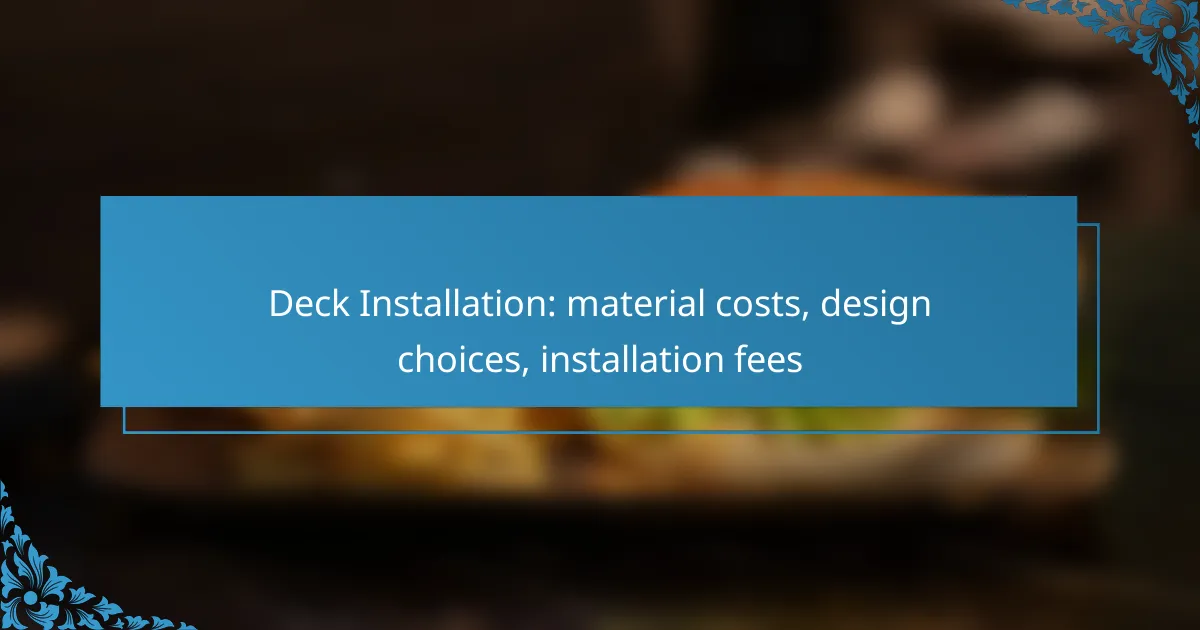Deck installation costs in Canada can range from several thousand to over ten thousand Canadian dollars, influenced by material choices, design preferences, and labor fees. Common materials such as wood, composite, and aluminum each present unique benefits and considerations that affect durability and maintenance. Thoughtful design is essential, as it should reflect your lifestyle and enhance the overall aesthetics of your home while maximizing the functionality of your outdoor space.

What are the costs of deck installation in Canada?
The costs of deck installation in Canada can vary significantly based on materials, design choices, and labor fees. Homeowners should expect to invest anywhere from several thousand to over ten thousand Canadian dollars, depending on their specific requirements and preferences.
Material costs overview
Material costs for deck installation in Canada typically range from CAD 15 to CAD 50 per square foot. Common materials include pressure-treated wood, composite decking, and hardwoods, each with its own price point and durability. For example, pressure-treated wood is often the most affordable option, while composite materials tend to be more expensive but require less maintenance.
When selecting materials, consider not only the initial cost but also the long-term value. Higher-quality materials may have a higher upfront cost but can save money over time through reduced maintenance and replacement needs.
Labor fees breakdown
Labor fees for deck installation in Canada generally range from CAD 30 to CAD 70 per hour, depending on the contractor’s experience and the project’s complexity. Most deck installations can take anywhere from a few days to a week, depending on size and design intricacies. It’s advisable to obtain multiple quotes to ensure competitive pricing.
Additionally, some contractors may offer a flat rate for the entire project, which can simplify budgeting. Be sure to clarify what is included in the labor fees, such as site preparation and cleanup, to avoid unexpected costs.
Average total installation costs
The average total installation costs for a deck in Canada can range from CAD 5,000 to CAD 15,000, depending on size, materials, and labor. A standard 300-square-foot deck made from pressure-treated wood might cost around CAD 6,000 to CAD 8,000, while a similar-sized composite deck could range from CAD 9,000 to CAD 12,000.
When planning your budget, consider additional expenses such as permits, design fees, and any necessary landscaping adjustments. Setting aside an extra 10-20% for unforeseen costs can help ensure your project stays within budget.

What materials are commonly used for deck installation?
Common materials for deck installation include wood, composite, and aluminum. Each material offers distinct advantages and considerations, impacting durability, maintenance, and overall cost.
Wood decking options
Wood decking is a traditional choice, often made from softwoods like pine or hardwoods such as cedar and redwood. Softwoods are generally more affordable, costing around $2 to $5 per square foot, while hardwoods can range from $5 to $10 per square foot.
When selecting wood decking, consider factors like resistance to rot and insects. Pressure-treated wood is a popular option for its durability, but it requires regular maintenance, including sealing and staining, to prolong its lifespan.
Composite decking benefits
Composite decking, made from a blend of wood fibers and plastic, offers low maintenance and high durability. Prices typically range from $3 to $7 per square foot, making it a mid-range option compared to wood.
This material is resistant to fading, staining, and mold, which means it doesn’t need frequent sealing or painting. However, ensure proper ventilation during installation to prevent moisture buildup, which can lead to warping.
Aluminum decking features
Aluminum decking is a lightweight, durable option that is resistant to rust and corrosion. It generally costs between $8 and $12 per square foot, making it one of the pricier materials.
One of the key benefits of aluminum decking is its fire resistance and low maintenance requirements. It can be a good choice for areas prone to wildfires or extreme weather conditions. However, consider the thermal conductivity, as aluminum can become hot in direct sunlight.

How to choose the right design for your deck?
Choosing the right design for your deck involves considering your lifestyle, the intended use of the space, and the architectural style of your home. A well-planned design enhances functionality and aesthetics, ensuring that your deck complements your outdoor living experience.
Popular deck styles
There are several popular deck styles to consider, each offering unique benefits. Traditional decks often feature wooden materials and classic railings, while modern designs may incorporate composite materials and sleek lines. Other styles include multi-level decks, which provide varied elevation for visual interest, and wraparound decks that extend around the home for expansive views.
Additionally, you might explore specific themes such as rustic, contemporary, or coastal designs, which can be tailored to fit your personal taste and the surrounding environment. Each style can influence the choice of materials and layout, so it’s essential to align your design with your overall vision.
Factors influencing design choices
Several factors can influence your deck design choices, including budget, space availability, and local climate. For instance, if you live in an area with heavy rainfall, you may want to consider materials that resist moisture, such as composite decking. Budget constraints will also dictate the materials and features you can incorporate, so it’s wise to prioritize essential elements first.
Another important consideration is how you plan to use the deck. If you envision hosting gatherings, you might opt for a larger space with built-in seating and lighting. Conversely, a smaller deck may suffice for quiet relaxation. Always keep in mind local building codes and regulations, as these can affect your design options and may require permits for certain features.

What permits are required for deck installation in Canada?
In Canada, deck installation typically requires a building permit, which ensures compliance with local safety and zoning regulations. The specific permits needed can vary by province and municipality, so it’s essential to check with local authorities before beginning any construction.
Building permits overview
Building permits are legal documents issued by local governments that authorize construction projects. They ensure that the proposed work meets safety codes, zoning laws, and other regulations. Generally, a permit application will require details about the deck’s design, dimensions, and materials.
In many cases, the application process involves submitting plans and possibly paying a fee, which can range from a few dozen to several hundred Canadian dollars, depending on the project’s scope. Homeowners should allow sufficient time for permit approval before starting construction.
Local regulations in Ontario
In Ontario, deck installation is subject to specific regulations outlined in the Ontario Building Code and local municipal bylaws. Most municipalities require a building permit for decks that exceed a certain height, typically around 24 inches above ground level.
Additionally, homeowners must adhere to setback requirements, which dictate how far the deck must be from property lines. It’s advisable to consult with the local building department to understand the exact requirements and ensure compliance with all regulations before proceeding with the installation.

How long does deck installation take?
Deck installation typically takes anywhere from a few days to several weeks, depending on various factors such as the size of the deck, the materials used, and the complexity of the design. Homeowners should plan for potential delays due to weather or permit approvals.
Typical installation timeline
A standard deck installation can range from 1 to 3 weeks. Smaller decks may take about 1 week, while larger or more intricate designs can extend the timeline significantly. This includes time for site preparation, material delivery, and the actual construction process.
For example, a simple wooden deck might be completed in 5 to 7 days, while a composite deck with multiple levels and features could take 10 to 14 days. Always consult with your contractor for a more accurate estimate based on your specific project.
Factors affecting installation duration
Several factors can influence how long deck installation takes. These include the size of the deck, the type of materials chosen, and the complexity of the design. For instance, composite materials often require more precise installation techniques, which can add time to the project.
Weather conditions can also play a significant role. Rain or extreme temperatures may delay work, while permitting issues can extend timelines if local regulations require inspections or approvals. It’s wise to factor in these variables when planning your deck installation.

What are the maintenance costs for decks?
Maintenance costs for decks can vary significantly based on materials, climate, and usage. Generally, homeowners should budget for regular upkeep to ensure longevity and safety, which can include cleaning, sealing, and repairs.
Annual maintenance expenses
Annual maintenance expenses for decks typically range from $200 to $600, depending on the material used. Wood decks often require more frequent sealing and staining, while composite materials may need less upkeep.
Common maintenance tasks include power washing, applying sealants, and replacing damaged boards. Setting aside a budget for these tasks can help prevent larger, unexpected costs down the line.
Long-term upkeep considerations
Long-term upkeep for decks involves planning for major repairs or replacements every 10 to 20 years, depending on the material. For instance, treated wood may last around 15 years with proper care, while composite materials can last longer but may still require periodic replacement of components.
Consider local weather conditions when planning maintenance. Areas with heavy rainfall or snow may necessitate more frequent inspections and repairs to prevent rot or structural damage. Regularly checking for signs of wear can help you address issues before they escalate into costly repairs.

What are the best practices for deck installation?
Best practices for deck installation include careful planning, selecting quality materials, and following proper construction techniques. Ensuring compliance with local building codes and regulations is also crucial for a safe and durable deck.
Installation process steps
The installation process for a deck typically involves several key steps. First, you need to design the deck layout, considering factors like size, shape, and location. Next, obtain any necessary permits from local authorities to ensure compliance with regulations.
Once the design is approved, prepare the site by clearing the area and leveling the ground. Install footings and posts to provide a solid foundation, then lay the frame using joists and beams. Finally, attach the decking material, ensuring proper spacing and alignment.
After installation, conduct a thorough inspection to check for stability and safety. Regular maintenance, such as cleaning and sealing, will help prolong the life of the deck and keep it looking good.
